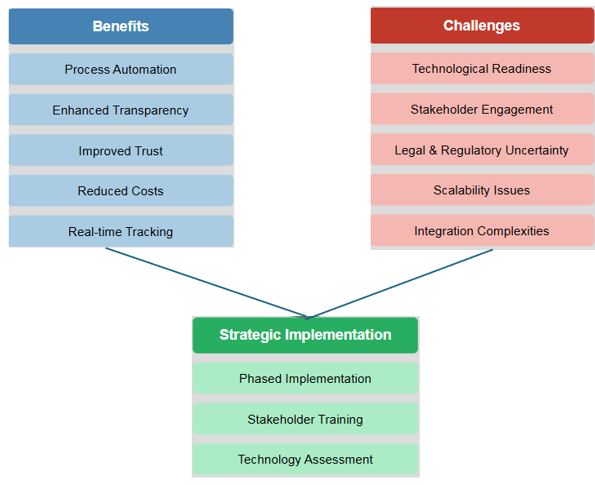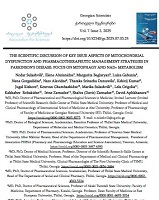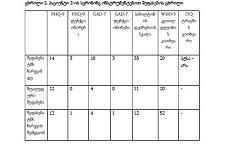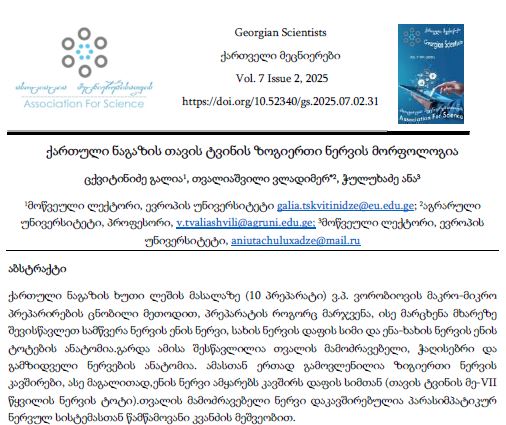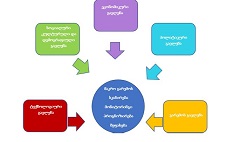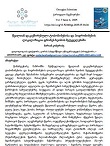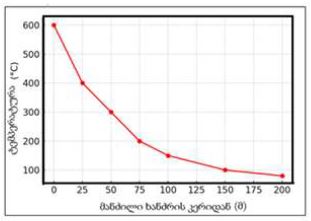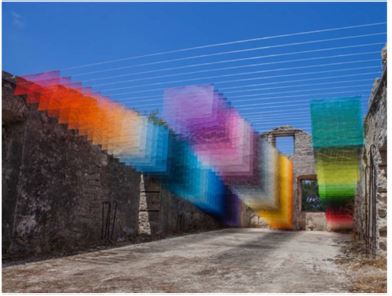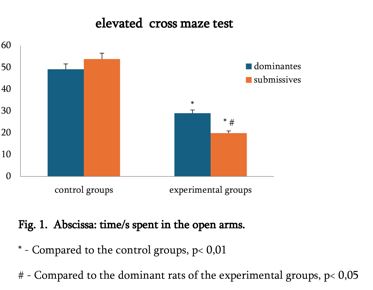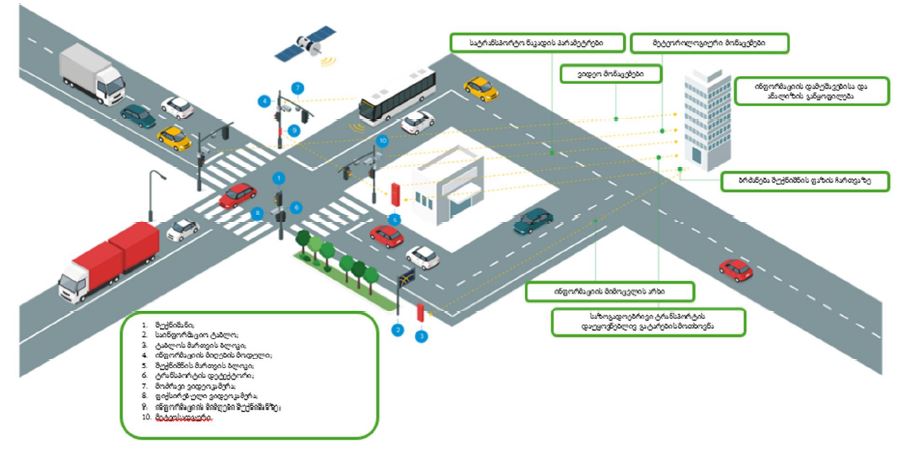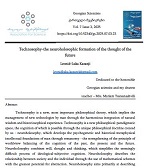ზღვის წყლის გასუფთავების კომპლექსური სორბციულ- მემბრანული მეთოდების შემუშავება
ჩამოტვირთვები
გარემოსდაცვითი ღონისძიებებიდან გაჭუჭყიანების პრევენციასთან ერთად მეტად მნიშვნელოვანია ტექნოლოგიური პროცესების სრულყოფა და ჩამდინარე წყლების გაწმენდა. ნავთობითა და ნავთობპროდუქტებით (ნ/პ) წყლების გაჭუჭყიანების მიზეზი შეიძლება გახდეს როგორც მცირე ობიექტი, საწარმო (ტექნიკური შემოწმების ან ბენზინგამმართველი სადგური, ნავთობბაზა, სადაც ინახება პროდუქტი), ასევე თანამედროვე ქარხნის ტექნოლოგიური კომლექსი. გარემოში მოხვედრილი ნავთობი თრგუნავს ადგილობრივ ეკოსისტემას და მიშვების შემთხვევაში ანადგურებს ფლორას და ფაუნას. ჩვენის კვლევის მიზანს წარმოადგენდა შავი ზღვის აჭარის სამხრეთ-აღმოსავლეთ აკვატორიის წყლების ნავთობით და ნავთობპროდუქტებით გაბინძურების შესწავლა, ნავთობით გაბინძურებული ზღვის წყლის კომპლექსური მეთოდით გაწმენდის შესაძლებლობის დადგენა, როცა გამფილტრავ მასალად გამოყენებულია იაფფასიანი პოლიმერული მასალა (ნარჩენი), საწარმოოს ნარჩენი ბუნებრივი მასალა (ხის ნახერხი) და ადვილად რეგენერირებადი მიკროფილტრი.
Downloads
Rotar, Olga, &Iskrizhitskaya, Darina. (2014). Cleanup of Water Surface from Oil Spills Using Natural Sorbent Materials. Procedia Chemistry,10, 145-150. doi:10.1016/j.proche.2014.10.025
Adebajo, M., & Frost,, R. (2003). Porous Materials for Oil Spill Cleanup: A Review of Synthesis and Absorbing Properties. Journal of Porous Materials,1-31.
SIROTKINA, E., & NOVOSELOVA, L. (2005). Materials for Adsorption Purification of Water from Petroleum and Oil Products. Chemistry for Sustainable Development,359-375.
Payne, K. C., Jackson, C. D., Aizpurua, C. E., Rojas, O. J., &Hubbe, M. A. (2012). Oil Spills Abatement: Factors Affecting Oil Uptake by Cellulosic Fibers. Environmental Science & Technology,46(14), 7725-7730. doi:10.1021/es3015524
Wahi, R., Chuah, L. A., Choong, T. S., Ngaini, Z., &Nourouzi, M. M. (2013). Oil removal from aqueous state by natural fibrous sorbent: An overview. Separation and Purification Technology,113, 51-63. doi:10.1016/j.seppur.2013.04.015
Nenkova,, S., Garvanska,, R., &Jelev, S. (2003). FIBROUS-WOOD SORBENT FOR ELIMINATING OIL POLLUTION. AUTEX Research Journal,4(3), 157-163.
Mahfoudhi, N., &Boufi, S. (2017). Nanocellulose as a novel nanostructured adsorbent for environmental remediation: A review. Cellulose,24(3), 1171-1197. doi:10.1007/s10570-017-1194-0
Paulauskienė, T., Jucikė, I., Juščenko, N., &Baziukė, D. (2014). The Use of Natural Sorbents for Spilled Crude Oil and Diesel Cleanup from the Water Surface. Water, Air, & Soil Pollution,225(6). doi:10.1007/s11270-014-1959-0
Deschamps, G., Caruel, H., Borredon, M., Bonnin, C., &Vignoles, C. (2003). Oil Removal from Water by Selective Sorption on Hydrophobic Cotton Fibers. 1. Study of Sorption Properties and Comparison with Other Cotton Fiber-Based Sorbents. Environmental Science & Technology,37(5), 1013-1015. doi:10.1021/es020061s
Wahi, R., Chuah, L. A., Choong, T. S., Ngaini, Z., &Nourouzi, M. M. (2013). Oil removal from aqueous state by natural fibrous sorbent: An overview. Separation and Purification Technology,113, 51-63. doi:10.1016/j.seppur.2013.04.015~
Bethrand Tabugbo et al. (2014). PREPARATION AND CHARACTERIZATION OF SAWDUST (CELLULOSE) AS AN ADSORBENT FOR OIL POLLUTION REMEDIATION. International Journal of Natural Science Research. 2(6), 97-102.მახაგონი და ნაძვი
D. Sidiras, F. Batzias at al. Development of oil Spill adsorbent from autohydrolysis modified lignocellulosic waste material. Resent Researches in Chemistry. p163-169 რემედიაცია იაფი ნედლეულით (ფართოფოთლოვანი და წიწვოვანი ხის ნახერხით)
Cojocaru, C., Macoveanu, M., & Cretescu, I. (2011, July). Peat-based sorbents for the removal of oil spills from water surface: Application of artificial neural network modeling. Colloids and Surfaces A: Physicochemical and Engineering Aspects, 384(1–3), 675–684. https://doi.org/10.1016/j.colsurfa.2011.05.036ტორფი
Nwadiogbu, J., Ajiwe, V., &Okoye, P. (2016). Removal of crude oil from aqueous medium by sorption on hydrophobic corncobs: Equilibrium and kinetic studies. Journal of Taibah University for Science,10(1), 56-63. doi:10.1016/j.jtusci.2015.03.014
Geetha K.S and Belagali S.L (2013) Adsorbtion studies of plant Base Oil and Minerals oils on Thea PowderWast. International Journal of Scientific and Research Publications, 3( 1)
El-Din, G. A., Amer, A., Malsh, G., & Hussein, M. (2017). Study on the use of banana peels for oil spill removal. Alexandria Engineering Journal. doi:10.1016/j.aej.2017.05.020
Method of removing oil from polluted water using expanded vermiculite.U.S. Patent No. US3414511A. (1967). Washington, DC: U.S. Patent and Trademark Office.
Okiel, K., El-Sayed, M., & El-Kady, M. Y. (2011). Treatment of oil–water emulsions by adsorption onto activated carbon, bentonite and deposited carbon. Egyptian Journal of Petroleum,20(2), 9-15. doi:10.1016/j.ejpe.2011.06.002
Bandura, L., Franus, M., Józefaciuk, G., &Franus, W. (2015). Synthetic zeolites from fly ash as effective mineral sorbents for land-based petroleum spills cleanup. Fuel,147, 100-107. doi:10.1016/j.fuel.2015.01.067
Sung, T., Yu, A., & Tan, Z. (2017). Oil adsorption performance and efficiency study on novel silane functionalized graphene polyurethane sponge. Waterloo, Ontario, Canada: University of Waterloo.
Gvazava, E., Maisuradze, N., &Samkharadze, I. (2016). Purification of Sewage Contaminated by Oil Products Using Mesoporous Coal. IOP Conference Series: Earth and Environmental Science,44, 052016. doi:10.1088/1755-1315/44/5/052016
Wang, G., &Uyama, H. (2016). Facile synthesis of flexible macroporous polypropylene sponges for separation of oil and water. Scientific Reports,6(1). doi:10.1038/srep21265
Alessandrello, M. J., Tomás, M. S., Raimondo, E. E., Vullo, D. L., & Ferrero, M. A. (2017). Petroleum oil removal by immobilized bacterial cells on polyurethane foam under different temperature conditions. Marine Pollution Bulletin,122(1-2), 156-160. doi:10.1016/j.marpolbul.2017.06.040
Mkheidze, N., Gotsiridze, R., Mkheidze, S., Tenieshvili, K. (2023). Production of the Microfiltration Membranes of Wide Range Porosity, High Mechanical, Thermal and Chemical Stability by "Green" Fabrication Method. Ecological Engineering & Environmental Technology, 24(8), 301-310. https://doi.org/10.12912/27197050/171608
საავტორო უფლებები (c) 2024 ქართველი მეცნიერები

ეს ნამუშევარი ლიცენზირებულია Creative Commons Attribution-NonCommercial-NoDerivatives 4.0 საერთაშორისო ლიცენზიით .























